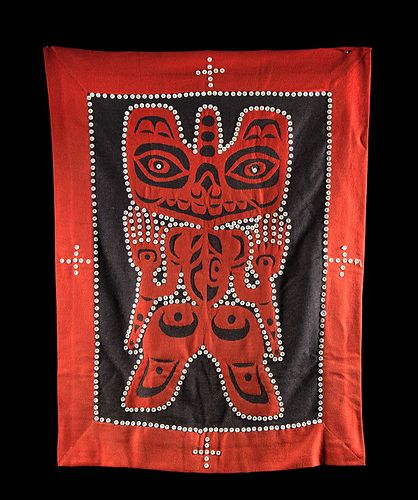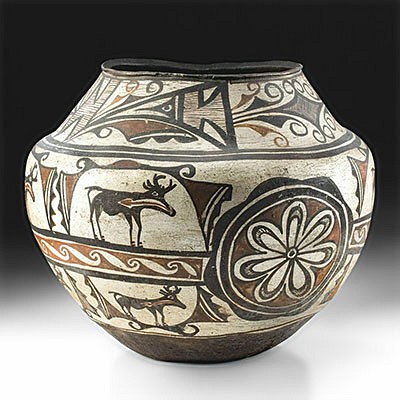20th C. Tlingit Felt & Button Blanket w/ Totemic Bear
Lot 17c
About Seller
Artemis Fine Arts
686 S Taylor Ave, Ste 106
Louisville, CO 80027
United States
Selling antiquities, ancient and ethnographic art online since 1993, Artemis Gallery specializes in Classical Antiquities (Egyptian, Greek, Roman, Near Eastern), Asian, Pre-Columbian, African / Tribal / Oceanographic art. Our extensive inventory includes pottery, stone, metal, wood, glass and textil...Read more
Categories
Estimate:
$3,000 - $4,500
Absentee vs Live bid
Two ways to bid:
- Leave a max absentee bid and the platform will bid on your behalf up to your maximum bid during the live auction.
- Bid live during the auction and your bids will be submitted real-time to the auctioneer.
Bid Increments
| Price | Bid Increment |
|---|---|
| $0 | $25 |
| $300 | $50 |
| $1,000 | $100 |
| $2,000 | $250 |
| $5,000 | $500 |
| $10,000 | $1,000 |
| $20,000 | $2,500 |
| $50,000 | $5,000 |
| $100,000 | $10,000 |
| $200,000 | $20,000 |
About Auction
By Artemis Fine Arts
Nov 18, 2021
Set Reminder
2021-11-18 10:00:00
2021-11-18 10:00:00
America/New_York
Bidsquare
Bidsquare : Art & Artifacts of North America
https://www.bidsquare.com/auctions/artemis-gallery/art-artifacts-of-north-america-7894
Join us for a special auction not to be missed! Collectible Native American art from antiquity to mid-20th century, Spanish Colonial, Latin American, Pre-Columbian, fine & folk art, American frontier items, fossils, and much more! Artemis Fine Arts info@artemisgallery.com
Join us for a special auction not to be missed! Collectible Native American art from antiquity to mid-20th century, Spanish Colonial, Latin American, Pre-Columbian, fine & folk art, American frontier items, fossils, and much more! Artemis Fine Arts info@artemisgallery.com
- Lot Description
Native American, Pacific Northwest, United States or Canada, Haida or Tlingit peoples, ca. early to mid-20th century CE. A remarkable example of traditional clothing known as a button blanket; a crest-style robe created for ceremonial use made from wool trade strouds and button accents. The central textile is a large dark brown wool panel, with red felt appliques and border. The appliques are hand stitched and depict a totemic bear with dozens of white buttons outlining the form. Additional buttons adorn the red border. A button blanket is a simple wool stroud that has been transformed into an item of pride - embellished with buttons and a central crest figure or symbol that denotes clan or family affiliation to wear during dances and potlatches. This is a truly fine example, and each stitch is visible on the verso, which demonstrates the painstaking and time-consuming process of hand stitching this intricate piece! Size: 44" L x 34" W (111.8 cm x 86.4 cm)
Robes, chilkats, and ceremonial capes were traditionally worn by Northwestern tribes to denote rank and clans, and before European contact, theses were usually made from hide, woven cedar bark, or even dog hair. In the 19th century the Hudson Bay Company traded many wool blankets with the coastal tribes and these plain blankets were transformed into the ceremonial and dancing regalia with the addition of buttons, appliques, and beads.
According to Polly Sargent and Doreen Jensen, co-authors of "Robes of Power: Totem Poles on Cloth" (1995) - the first oral history about these traditional works of fabric art and ritual, "The button blanket is eye-catching, prestigious and treasured - one of the most spectacular embellishments to the Indian culture of the Northwest Coast and a unique form of graphic and narrative art. The traditional crest-style robe is the sister of the totem pole and, like the pole, proclaims hereditary rights, obligations and powers. Unlike the pole, about which countless books and papers have been written, the button blanket has no chroniclers."
Provenance: private Alamo, California, USA collection, before 2000
All items legal to buy/sell under U.S. Statute covering cultural patrimony Code 2600, CHAPTER 14, and are guaranteed to be as described or your money back.
A Certificate of Authenticity will accompany all winning bids.
PLEASE NOTE: Due to recent increases of shipments being seized by Australian & German customs (even for items with pre-UNESCO provenance), we will no longer ship most antiquities and ancient Chinese art to Australia & Germany. For categories of items that are acceptable to ship to Australia or Germany, please contact us directly or work with your local customs brokerage firm.
Display stands not described as included/custom in the item description are for photography purposes only and will not be included with the item upon shipping.
#167569Choice. Minor fraying to button threads and seams of red border, but all pieces are secure and intact. Slight fading to red cloth pigments. We recommend mounting in a case to protect the fibers.Condition
- Shipping Info
-
All shipping is handled in-house for your convenience. Your invoice from Artemis Gallery will include shipping calculation instructions. If in doubt, please inquire BEFORE bidding for estimated shipping costs for individual items.
-
- Buyer's Premium



 EUR
EUR CAD
CAD AUD
AUD GBP
GBP MXN
MXN HKD
HKD CNY
CNY MYR
MYR SEK
SEK SGD
SGD CHF
CHF THB
THB













